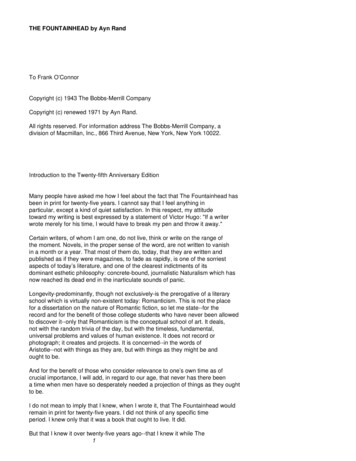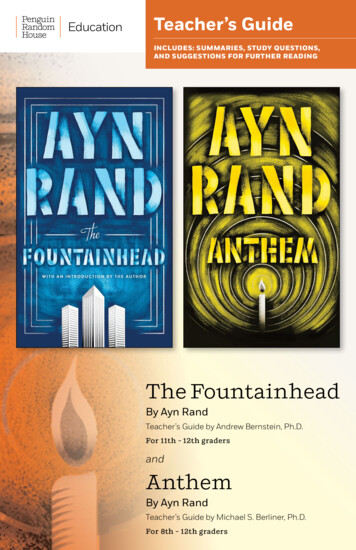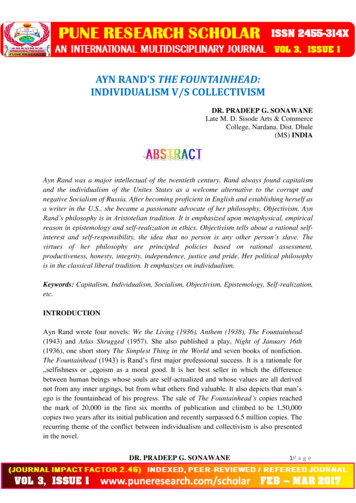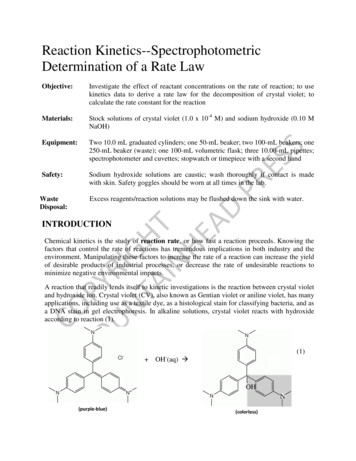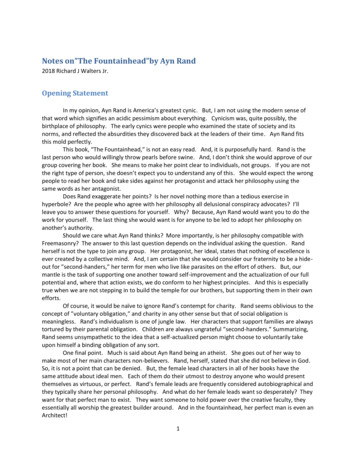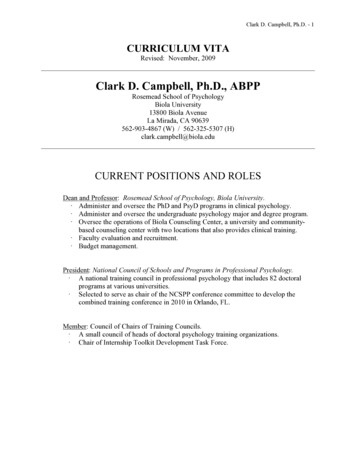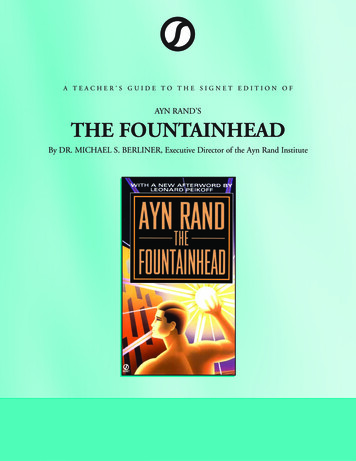
Transcription
#BAMNextWave2017 BAM Next Wave FestivalBrooklyn Academy of MusicAdam E. Max,Chairman of the BoardKaty Clark,PresidentWilliam I. Campbell,Vice Chairman of the BoardJoseph V. Melillo,Executive ProducerTheFountainheadBased on the book by Ayn RandToneelgroep AmsterdamDirected by Ivo van HoveBAM Howard Gilman Opera HouseNov 28—30, Dec 1 & 2 at 7pmRunning time: approx. four hours, including intermissionTranslation by Erica van Rijsewijk, Jan van RheenenAdaptation by Koen TacheletDramaturgy by Peter Van KraaijSet and lighting design by Jan VersweyveldMusic by Eric SleichimVideo design by Tal YardenCostume design by An D’HuysIn Dutch with English titlesThe 2017 Richard B. Fisher Next Wave Award honorsIvo van Hove and the production of The Fountainhead.Season Sponsor:Major support provided by Edward Jay Wohlgemuth and The Dutch Performing Arts Fund NL.Support for the Signature Artist Series provided by the Howard Gilman Foundation.Leadership support for Diverse Voices programming at BAM provided by the Ford Foundation.Major support for theater at BAM provided by:The Achelis and Bodman FoundationThe Francena T. Harrison Foundation TrustThe SHS FoundationThe Shubert Foundation, Inc.
THE FOUNTAINHEADROBERT DE HOOGHÉLÈNE DEVOSAUS GREIDANUS JR.HANS KESTINGHUGO KOOLSCHIJNRAMSEY NASRFRIEDA PITTOORSHALINA REIJNBART SLEGERS
THE FOUNTAINHEADCASTHoward RoarkRamsey NasrPeter KeatingAus Greidanus jr.Ellsworth TooheyBart SlegersGuy Francon, Henry CameronHugo KoolschijnGail WynandHans KestingDominique FranconHalina ReijnMrs. KeatingFrieda PittoorsCatherine HalseyHélène DevosSteven Mallory, Alvah ScarretRobert de HoogADDITIONAL CREDITSMusic Bl!ndman (drums); Yves Goemaere, Hannes Nieuwlaet, Christiaan SarisPrivate producer Emmerique Granpré MoliereThe Fountainhead by Ayn RandUsed by permission of Curtis Brown Ltd. Copyright 1943All rights reserved
THE FOUNTAINHEADSUMMARYHoward Roark is a self-willed architect with just one desire: to shape the material Earth has to offerhim according to his own ideal. This proves no simple task in a world in which creative energy iscertain to lose out to commercial success, social interests, and power. Through flattery and intrigueRoark’s ambitious fellow student Peter Keating soon rises to the upper echelons of architecture whilejournalist Ellsworth Toohey manipulates public opinion in the popular newspaper The New YorkBanner. And then there’s Gail Wynand, the influential owner of the Banner: a man who has sold hissoul to the masses in exchange for power.When Howard Roark meets Dominique Francon he finds a kindred spirit. Between Dominique, whois disappointed in mankind, and the impassioned Roark, a raw romance develops, which reveals howdifficult it is to give yourself to another and yet remain true to yourself. How great are the sacrifices youcan make to stay independent?In The Fountainhead Ayn Rand conscientiously portrays the struggle between holding on to your ownvision and deferring to others. She puts forward a man who is solely driven by his passion and hiscreative power, a person who doesn’t live for other people.AYN RAND, AUTHORAyn Rand was born Alissa Zinovievna Rosenbaum in Russia’s St. Petersburg on the eve of thecommunist revolution. At a young age Rand developed the fundamentals of her philosophy of life,which is a plea in favor of the absolute value of the individual and against anything that alludes tocollectivism or religious mysticism. At age 20, she changed her given name Alissa Rosenbaum toAyn Rand and left for America to fulfil her dream: to become a writer and share her convictions withthe world. Although her novels were received with suspicion by critics, Rand attracted a flock ofpassionate followers who identified with her radical-individualist, neo-liberal view on the world.The power of the creator is one of the guiding principles in Rand’s philosophy of selfishness, whichshe baptized “objectivism.” Whereas The Fountainhead (1943) is a romantic-philosophical depictionof the writer’s ideals, Rand later embarks on an increasingly political and social course in her work.In her magnum opus Atlas Shrugged (1957) the creative individual is no longer simply significantin terms of autonomous creativity, but also in terms of politics and society. The independent creatorbecomes the pivot of Rand’s philosophical system: as a creator of their own happiness, but also as thecreator of a successful individualist-leaning society.Where Atlas Shrugged is generally perceived as the most comprehensive depiction of Rand’sphilosophy of objectivism, The Fountainhead sees her draw a meticulous picture of the strugglebetween the powers of individualism and collectivism, “not in politics, but within a man’s soul.”
Photo: Yannick GrandmontPhoto: Jan Versweyveld
NOTESON DIRECTOR IVO VAN HOVEAyn Rand outlines her ideal man in TheFountainhead. Protagonist Howard Roarkrepresents a pure and uncompromising humanbeing that is guided by his own rational insights.His goal is to create a better and more beautifulworld through his work. But Roark is not alone:the characters surrounding him create a forcefield of divergent world visions.In Ivo van Hove’s direction the characterscontinuously ask themselves the question of howthey should relate to the world and the peoplearound them. The Fountainhead is a layeredworld in which people converge and share theirviews, but also struggle to realize their visions.Although Rand wrote The Fountainhead over 70years ago, the themes she deals with are stillhugely topical. By whom and by what do welet our identity be determined? Is it really of thegreatest importance to stay uncompromisinglytrue to yourself? The author’s answer is clear andunequivocal, but van Hove doesn’t hesitate tomercilessly dissect the complexity of Ayn Rand’sweb of individuals, who each foster their ownaspirations. The intense love between HowardRoark and Dominique Francon is an importantstoryline in the novel. The main narrative oftheir relationship continuously balances on theperilous boundary between sincere idealism andseemingly inescapable destruction.On the basis of the binding subject ofarchitecture (perhaps the most utopian of all artforms by virtue of its public and communal form)van Hove outlines an image of the problematicrelationship between art and society. For howcan art as an expression of individual vision becoupled with social relevance? The Fountainheadis a play about passion, about driven people, aperformance about a divided sense of idealismand the human relations this conflict produces.ON SCENOGRAPHY AND LIGHTING DESIGNERJAN VERSWEYVELDOn the set of The Fountainhead everything is inmotion: Jan Versweyveld’s decor is designed asan industrial space of ideas in which not onlythe characters but also musicians and stagetechnicians are constantly busy creating texts,images, and music. On stage, personal workareas have been installed in which the realmof Ayn Rand’s ideas can be converted into thedynamics of an idea as it is being executed. It isa space where everyone “works together.” Theideas and artistic and personal processes thatensue from this propel the characters throughVersweyveld’s space.ON VIDEO DESIGNER TAL YARDENThe video images by Tal Yarden closely showhow an architectural idea develops into a visibleshape. The visualization of this creative processaffords the viewer a glance at the artist’s reality:how is the thought of an art work transformedinto a concrete result?ON MUSIC DESIGNER ERIC SLEICHIMThe musical design by Eric Sleichim, performedlive by two musicians and a stage technician,plays with electronics and unusual musicalinstruments such as the bass marimba and thetheremin, but also uses construction materials.This gives rise to a laboratory which constantlyinteracts musically with the developmentson stage.The Fountainhead is a visual and auditory praiseof living art: a search for both the power ofmaterials and a rendition of the dynamic world ofthe creative artist.
Who’s WhoIVO VAN HOVE (director) has held centralpositions in Dutch-Belgian cultural life, first asthe head of Het Zuidelijk Toneel from 1990 to2000, from 1997 to 2004 leading the annualHolland Festival, and from 2001 as generaldirector of Toneelgroep Amsterdam. Along withhis frequent guest directing at the New YorkTheatre Workshop, Van Hove has directedcompanies from the Deutsches Schauspielhausin Hamburg, the Schaubuehne in Berlin and theMünchner Kammerspiele. He also staged operaat the Flemish Opera, La Monnaie in Brussels,and De Nederlandse Opera in Amsterdam. In2014 he staged the world premiere of the operaBrokeback Mountain at Teatro Real. Van Hovedirected A View from the Bridge (2015) andThe Crucible (2016) on Broadway and Lazarus,David Bowie’s musical theater show, in NewYork. For Dutch television, he made Home Frontand in 2009, his first feature film Amsterdamwas released. Van Hove has received manyaccolades, including two Obie Awards in NewYork (More Stately Mansions and Hedda Gabler),the Flanders Oeuvre Prize (1995), the TheatreFestival Prize (1996), and the Archangel Awardat the Edinburgh Festival (1999). He was madea knight of the Ordre des Arts et des Lettres inFrance in 2004. In 2007 he received the prizeawarded by Dutch theater critics. In 2008, healso received the Prosceniumprijs, the Dutchoeuvre prize, together with Jan Versweyveld,and in 2012 the Amsterdam Business OeuvreAward. In 2014 Van Hove received an honorarydoctorate for general merit of the Universityof Antwerp. In 2015 he received two OliverAwards (A View from the Bridge) and theAmsterdam Prize for Art. In 2016, Van Hovereceived two Tony Awards, two Drama LeagueAwards, two Drama Desk Awards, two OuterCritics Circle Awards, and two Grands Prix dela Critique. King Filip of Belgium awarded VanHove Commander of the Order of the Crown.During the last few years Van Hove has directed,among others, Rocco and His Brothers byLuchino Visconti and Teorema, based on thework of Pier Paolo Pasolini (both in partnershipwith the Ruhrtriennale), Antonioni Project byMichelangelo Antonioni, Cries and Whispersand After the Rehearsal / Persona by IngmarBergman, Summer Trilogy by Carlo Goldoni, TheRussians! by Tom Lanoye based on Chekhov,Mourning Becomes Electra and Long Day’sJourney Into Night by O’Neill, The Fountainheadby Ayn Rand, and Mary Stuart by FriedrichSchiller at Toneelgroep Amsterdam. Awardwinning repertoire of TA includes Shakespeare’sRoman Tragedies (2012 Next Wave) and TheTaming of the Shrew, Tony Kushner’s Angelsin America (2014 Next Wave), IngmarBergman’s Scenes from a Marriage, and JohnCassavetes’ Husbands and Opening Night(2008 Next Wave).JAN VERSWEYVELD (set and lighting design)has been a guest lecturer at the Gerrit RietveldAcademy and is one of the cofounders of thescenography training program in Antwerp.He has been responsible for designing thescenes and lighting for a wide variety oftheater productions, ranging from the classics(Sophocles, Euripides, Shakespeare, andMarlowe) to modern plays (Williams, O’Neill,Camus, Mauriac, Genet, and Sontag). His oeuvreincludes theater, dance (Rosas), and opera:Lulu and the complete Ring des Nibelungen bythe Flemish Opera, I due Foscari by the MuntOpera, Fidelio at L’Opéra Palais Garnier and Dezaak Makropulos, and La clemenza di Tito andIolanta by the Netherlands Opera. In additionto his work with Ivo van Hove and Anne TeresaDe Keersmaeker, he has also collaboratedwith many internationally renowned directors,including Johan Simons and Pierre Audi.He won the Bessie Award in New York for hisscenography for Drumming Live, and he receivedthe Obie Award for Hedda Gabler. In 2008, hereceived the Prosceniumprijs, a Dutch theaterprize and in 2015 the Amsterdam Prize for Art,together with Ivo van Hove. His scenographyfor Scenes from a Marriage at the New TheatreWorkshop was awarded with the Lucille LortelAward for Outstanding Scenic Design.AUS GREIDANUS JR. (Peter Keating) joined theTA ensemble at the end of 2013—14 season.In the 2017—18 season he will perform in thepremiere of Oedipus (director Robert Icke) andin the revivals of The Things That Pass, IbsenHouse, Medea, Kings of War, The Fountainhead,and Othello. Greidanus jr. played before at TAin The Hidden Force, Husbands and Wives,The Kindly Ones, Nora, La Grande Bouffe, and
Photo: Jan Versweyveld
The Richard B.FisherNext Wave AwardBehind great arts presenters are greatsupporters, and few of BAM’s friends havedeserved that title more than Richard B.Fisher (1936—2004). A visionary in bothprofessional and philanthropic endeavors,Dick championed the creation of a strongendowment to enable BAM to continuepresenting its signature groundbreakingprogramming, even in difficult times. AsChairman of the BAM Endowment Trust from1992-2004, Dick shared financial expertisefrom years as president, chairman, andchairman emeritus of Morgan Stanley.Dick’s generosity throughout his lifecontinued even after his passing in the formof a landmark bequest. To honor Dick’sfriendship to BAM and recognize the legacyof progressive arts presentations he helpedensure in Brooklyn, BAM inaugurated the annual Richard B. Fisher Next Wave Awardin 2006. Each year, members of the Fisher family help BAM select the engagementthat best exemplifies Dick’s forward-thinking ethos and passion for the arts, usingthis opportunity to celebrate Richard B. Fisher in perpetuity. Past recipients haveincluded Pina Bausch, Charles Mee, Bill T. Jones, Robert Wilson, Mark Morris,Kronos Quartet, Anne Bogart, Fiona Shaw, Brooklyn Youth Chorus, James Thierrée,and David Lang.The 2017 Richard B. Fisher Next Wave Award honors Ivo van Hove and theToneelgroep Amsterdam production of The Fountainhead.
Ivo van Hove—hailed by The New York Times as “an artist seeking, as Ibsenonce did, to illuminate the world around him”—has been the general director ofToneelgroep Amsterdam since 2001. In addition to working with the company,he has directed imaginative productions of The Little Foxes, Hedda
Whereas The Fountainhead (1943) is a romantic-philosophical depiction of the writer’s ideals, Rand later embarks on an increasingly political and social course in her work. In her magnum opus Atlas Shrugged (1957) the creative individual is no longer simply significant in terms of autonomous creativity, but also in terms of politics and society. The independent creator becomes the pivot of .
